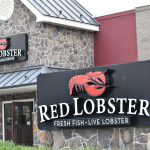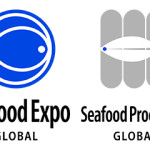If there’s one thing that gets Tom Kime riled up, it’s restaurateurs selling seafood with a questionable provenance and passing it off as a product from somewhere else.
“I think complete traceability is important,” says Kime, chef and owner of the Sydney, Australia, café Fish & Co., author and sustainable seafood advocate. “Without country of origin labeling it’s easy to say a species is sustainable or wild caught, when in fact it’s not.”
One wall inside of Fish & Co. features a large map containing information on where species served in the café come from. Kime, a firm believer in educating his diners, says that only by having access to information can consumers make better, more informed choices about what seafood they eat. Thus, he’s been a strong and vocal supporter of the LabelMyFish campaign.
Launched in Australia in October 2014, the campaign’s goal is to legislate clear seafood labeling. Specifically, its advocates — Greenpeace Australia Pacific, the Australian Marine Conservation Society, Zoos Victoria, Taronga Zoo and Sealife Australia, as well as celebrity chef Matthew Evans — are demanding labeling that includes the species of fish, its country of origin and information on how it was caught or farmed.
“While most of us think we’re eating Australian seafood, about 72 percent of what we eat is imported,” says the LabelMyFish website. Seafood labeling, it claims, will allow Australian consumers to choose sustainable seafood and make healthy choices in terms of what they eat. As an example, it cites “some shark species” as containing high levels of mercury. “Because of poor labeling people eat it unaware of the consequences. Australia’s weak seafood labeling laws mean we’re eating in the dark.”
Thanks to significant investment in traceability skills-training and infrastructure from fishermen, most of the background information the campaign is requesting is already available when domestic fish arrives at major fish markets in Sydney, Melbourne and Brisbane, said Nathaniel Pelle, oceans campaigner for Greenpeace.
“But that information is lost at the middleman, wholesaler and marketer level, or at the restaurant level, because wholesalers choose not to pass the information onto their customers unless they demand it,” he said. If the system was to be legislated and not voluntary as it currently stands, communicating seafood labeling to consumers would less complicated, he added, since restaurateurs could add that information to their menu or signage.
At the Seafood Importers Association of Australia, Chairman Norman Grant is vehemently opposed to the extension of Country of Origin Labeling (COOL) to foodservice. “It won’t achieve the results local producers or conservationists expect,” he said. “There’s been no study to assess the cost versus the benefit, and if COOL is introduced it could seriously impact sales in some outlets, because the community has been saturated with misleading negative information about imports.”
Grant said legislation proposed by LabelMyFish could affect 80,000 foodservice outlets and add AUD 300 million (USD 246 million; EUR 197 million) in annual costs, a figure the Restaurant & Catering Association of Australia says accurately reflects the costs of menu and signage change, staff training and other measures to implement clear seafood labeling. Kime is adamant the figure is inaccurate. “That’s totally overrated,” he insists. “It’s just scare-mongering from people who don’t want change.”
Change isn’t necessary, Grant countered, because “legislation already exists requiring vendors to provide an honest verbal answer to questions about the meals they sell. That is far more likely to provide better information to consumers than a couple of words on a menu, and it’s a cost-effective solution that’s already in place. If more people simply asked, surely management would ensure that staff get better at answering?”
On a more fundamental note, this legislation would not result in more domestic seafood being sold for the simple reason that the volume is not available, he said, adding that “Australia’s wild catch is already at the limits of sustainable production with no significant increases predicted.”
Local product is not consistently available at steady prices because most domestic seafood is seasonal. Further, it’s only available in generic forms “because it’s too expensive to process and value-add in Australia, which means it’s increasingly sent overseas for processing,” said Grant.
He added that concerns about safety of imported seafood are unfounded because most consumers aren’t aware that the standards of international food production are more demanding than those in Australia, and that all imported seafood products are subjected to a mandatory inspection and testing regime by the Department of Agriculture. “The assumption that Australian seafood is always more sustainably produced than imports is an oversimplification that can mislead consumers,” he said.
On this matter, he and Kime are in agreement. “We have to educate the public that certain fisheries abroad are doing an incredibly good job in terms of obtaining certification for their seafood,” Kime said. “There’s a misconception that seafood from Asia is bad. Conversely, just because seafood comes from Australia, doesn’t make it better than seafood from elsewhere.”
Grant cited Barramundi as an example. “The world’s largest individual source of sea-cage barramundi is from a company in Vietnam which was rated by Seafood Watch as ‘best choice.’ By contrast, Greenpeace and the Australian Marine Conservation Society recommend consumers eat less barramundi caught in the Northern Territory or Western Australia and avoid Queensland-caught barramundi due to concerns over impacts of fishing on vulnerable marine wildlife. Thus consumers relying on COOL labeling could be as misinformed about sustainability as they would be informed.”
Were the LabelMyFish campaign to succeed, restaurants would remove seafood from their menus altogether, said John Hart, chief executive officer of the Restaurant & Catering Industry Association of Australia.
“It’s just too complicated and expensive to keep changing the menu,” he said, adding that it’s unlikely LabelMyFish will ever be legislated, because its advocates would need to convince each state individually to adopt the proposal. “It would be a very difficult process since I can’t see there’s a legislative instrument that exists in the state to do this, and it’s unlikely even to be thought about within the next three to four years.”
What the issue boils down to is public perception, and the public is concerned about seafood quality, Hart says. “The reality is that the majority of our local catch is static, is exported and is not consumed by Australians at all. Of the seafood we consume in restaurants, 73 percent is imported. So the way seafood is dealt with locally has very little impact on how it’s consumed at a restaurant table.”
Kime disagrees. “LabelMyFish and CoOL will educate consumers, and the more educated the customer is, the better their position is to make choices about their seafood,” he says. In Australia’s Northern Territories, legislation exists requiring restaurants to label whether or not a product is imported. “They found there was a marked increase in people choosing local fish again, as opposed to the imported white fish that was cheaper,” he says. “I think that’s a fantastic example of why country of origin labeling works.”





